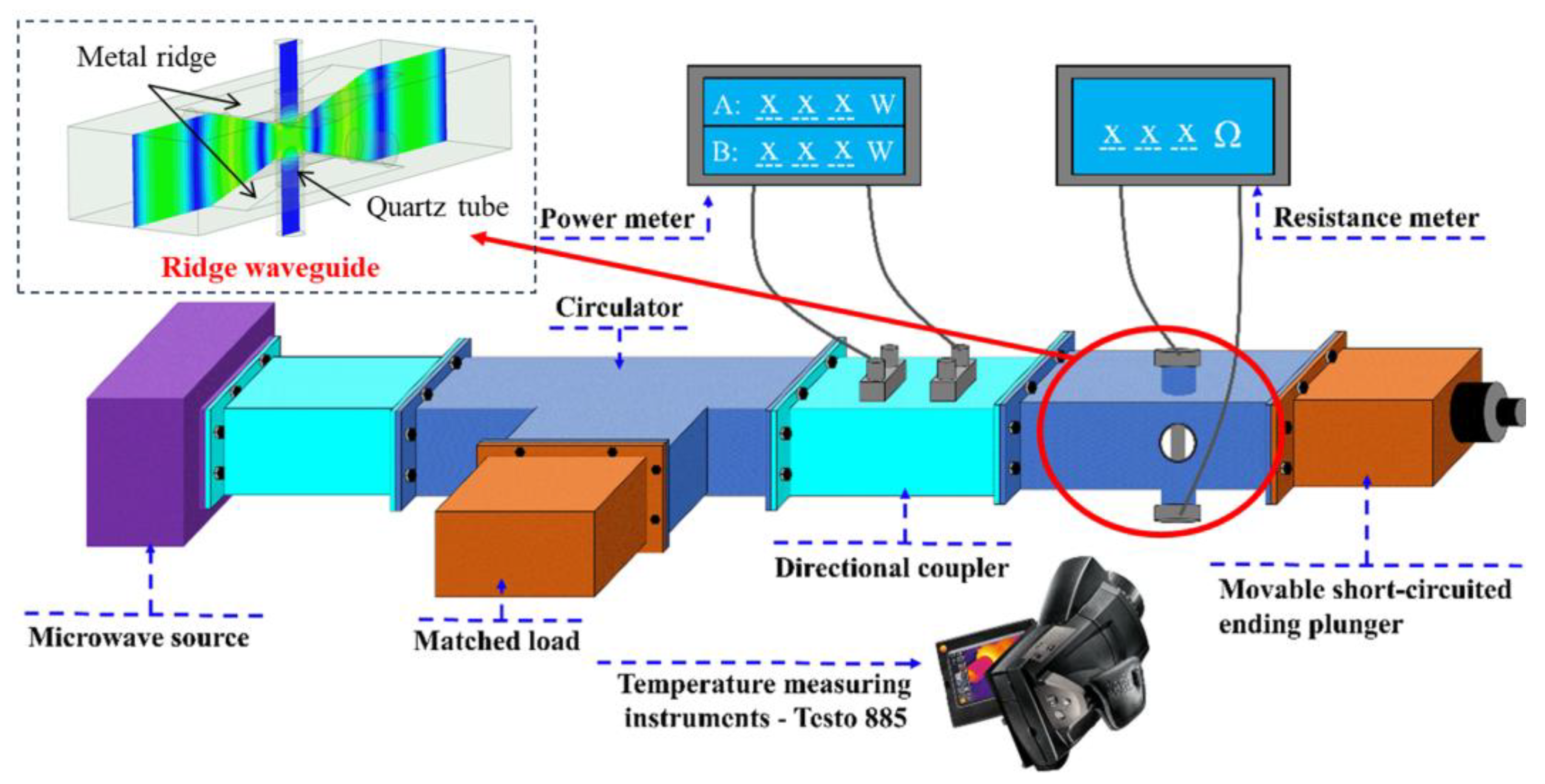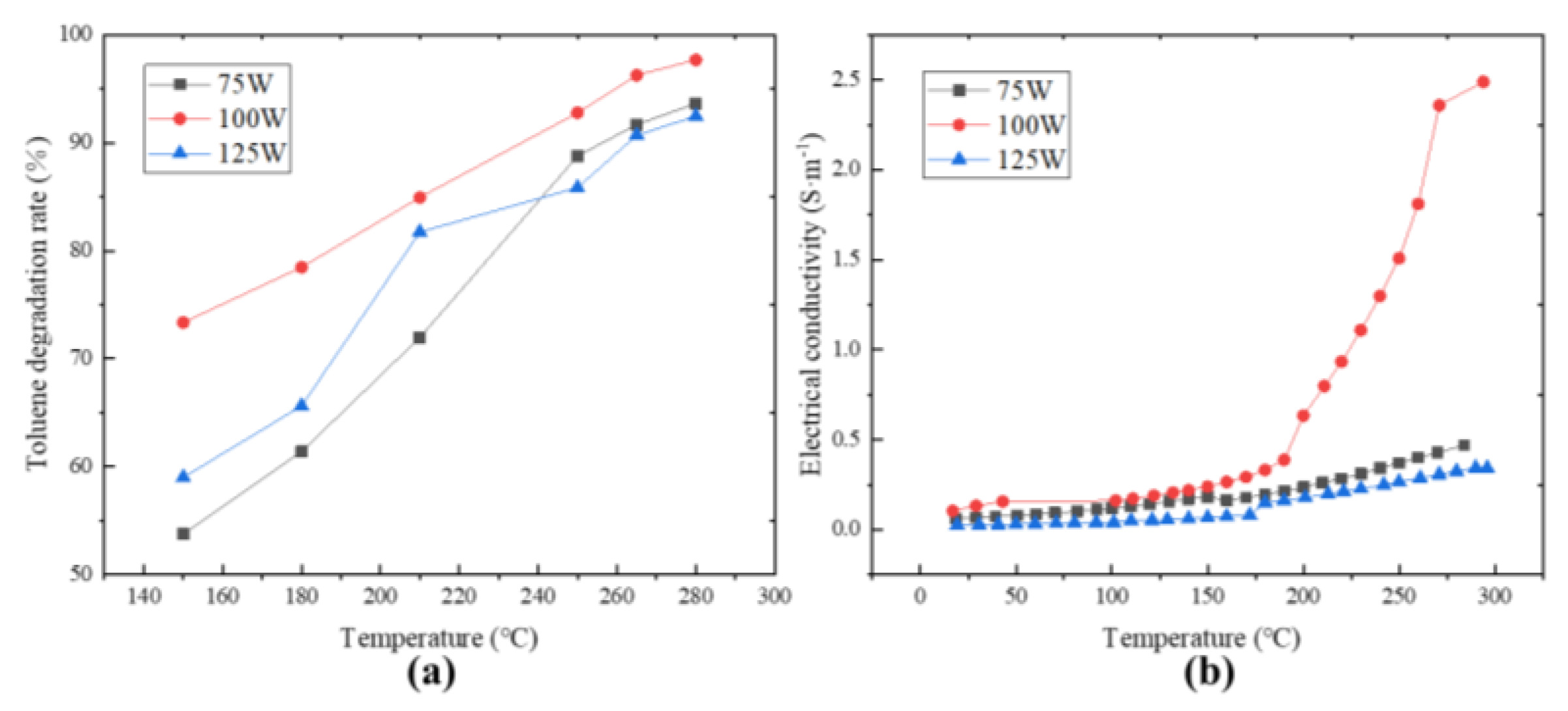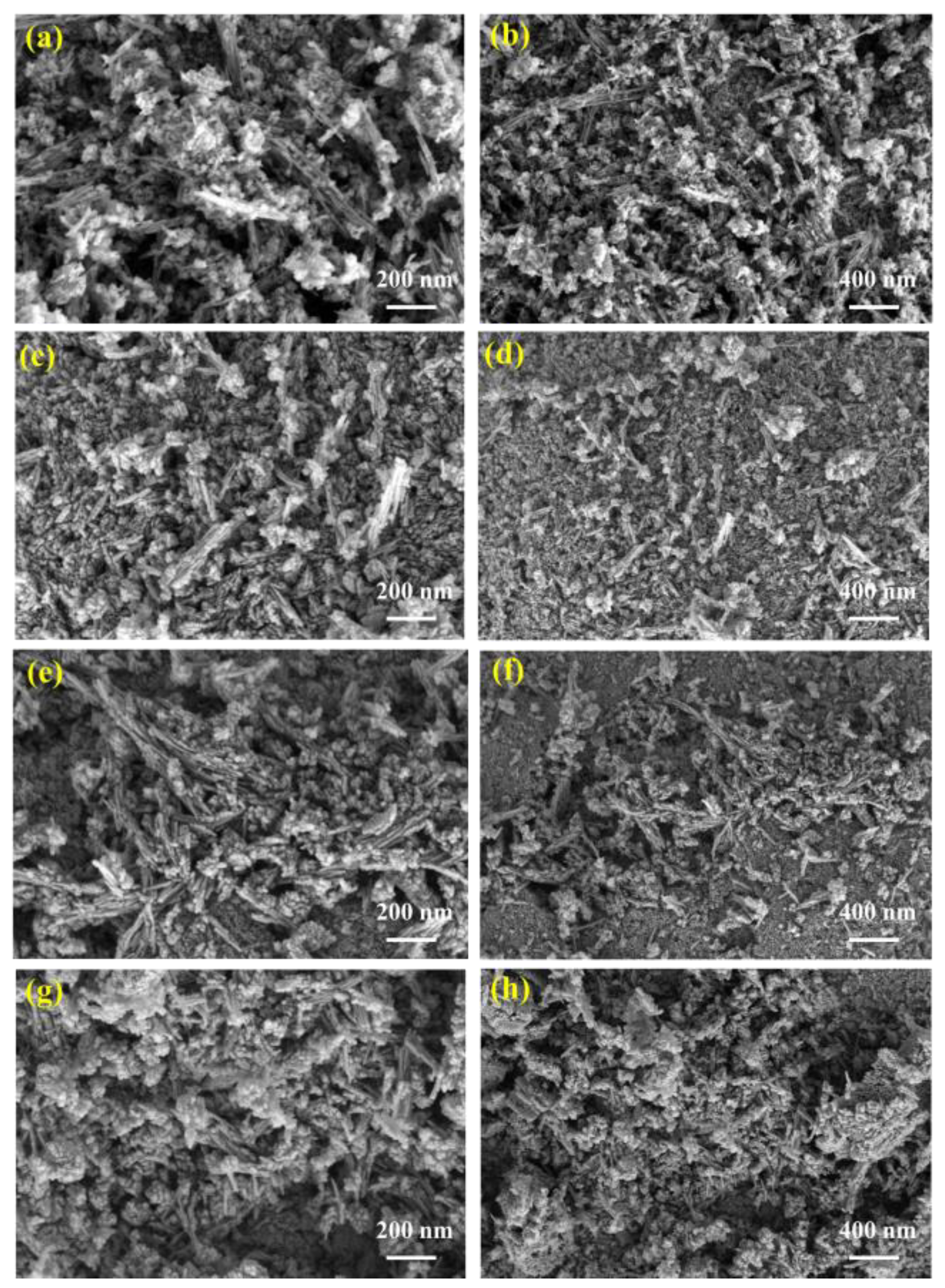Analysis of Microwave Effects on the MnO2-Catalyzed Toluene Oxidation Pathway
Abstract
1. Introduction
2. Experiment and Material Characterization
2.1. Experiment of Conductivity Measurement and Microwave Enhancement
2.2. Catalyst Characterization Methods
3. Results and Discussion
3.1. The Relationship between Toluene Degradation Rate and Conductivity Changes under Microwave Irradiation
3.2. Catalyst Characterization
3.2.1. XRD Characterization
3.2.2. XPS Characterization
3.2.3. SEM Characterization
4. Conclusions
Author Contributions
Funding
Data Availability Statement
Conflicts of Interest
References
- Wu, J.; Zhu, X.; Cai, Y.; Tu, X.; Gao, X. Coupling nonthermal plasma with V2O5/TiO2 nanofiber catalysts for enhanced oxidation of ethyl acetate. Ind. Eng. Chem. Res. 2019, 58, 2–10. [Google Scholar] [CrossRef]
- Li, Z.; Liu, J.; Gao, B.; Bo, L. Cu-Mn-CeOx loaded ceramic catalyst for non-thermal sterilization and microwave thermal catalysis of VOCs degradation. Chem. Eng. J. 2022, 442, 136288. [Google Scholar] [CrossRef]
- Saoud, W.A.; Kane, A.; Le Cann, P.; Gerard, A.; Lamaa, L.; Peruchon, L.; Brochier, C.; Bouzaza, A.; Wolbert, D.; Assadi, A.A. Innovative photocatalytic reactor for the degradation of VOCs and microorganism under simulated indoor air conditions: Cu-Ag/TiO2-based optical fibers at a pilot scale. Chem. Eng. J. 2021, 411, 128622. [Google Scholar] [CrossRef]
- Zhang, X.; Wang, J. Dose-response relation deduced for coronaviruses from coronavirus disease 2019, severe acute respiratory syndrome, and middle east respiratory syndrome: Meta-analysis results and its application for infection risk assessment of aerosol transmission. Clin. Infect. Dis. 2021, 73, e241–e245. [Google Scholar] [CrossRef]
- Kurniawan, T.A.; Haider, A.; Ahmad, H.M.; Mohyuddin, A.; Aslam, H.M.U.; Nadeem, S.; Javed, M.; Othman, M.H.D.; Goh, H.H.; Chew, K.W. Source, occurrence, distribution, fate, and implications of microplastic pollutants in freshwater on environment: A critical review and way forward. Chemosphere 2023, 325, 138367. [Google Scholar] [CrossRef] [PubMed]
- Kuang, H.; Li, Z.; Lv, X.; Wu, P.; Tan, J.; Wu, Q.; Li, Y.; Jiang, W.; Pang, Q.; Wang, Y.; et al. Exposure to volatile organic compounds may be associated with oxidative DNA damage-mediated childhood asthma. Ecotoxicol. Environ. Saf. 2021, 210, 111864. [Google Scholar] [CrossRef] [PubMed]
- Bari, M.A.; Kindzierski, W.B. Ambient volatile organic compounds (VOCs) in communities of the Athabasca oil sands region: Sources and screening health risk assessment. Environ. Pollut. 2018, 235, 602–614. [Google Scholar] [CrossRef] [PubMed]
- Kuranchie, F.A.; Angnunavuri, P.N.; Attiogbe, F.; Nerquaye-Tetteh, E.N. Occupational exposure of benzene, toluene, ethylbenzene and xylene (BTEX) to pump attendants in Ghana: Implications for policy guidance. Cogent. Environ. Sci. 2019, 5, 1603418. [Google Scholar] [CrossRef]
- Brummer, V.; Teng, S.Y.; Jecha, D.; Skryja, P.; Vavrcikova, V.; Stehlik, P. Contribution to cleaner production from the point of view of VOC emissions abatement: A review. J. Clean. Prod. 2022, 361, 132112. [Google Scholar] [CrossRef]
- Guo, Y.; Wen, M.; Li, G.; An, T. Recent advances in VOC elimination by catalytic oxidation technology onto various nanoparticles catalysts: A critical review. Appl. Catal. B Environ. 2021, 281, 119447. [Google Scholar] [CrossRef]
- Wang, Y.; Ding, L.; Shi, Q.; Liu, S.; Qian, L.; Yu, Z.; Wang, H.; Lei, J.; Gao, Z.; Long, H.; et al. Volatile organic compounds (VOC) emissions control in iron ore sintering process: Recent progress and future development. Chem. Eng. J. 2022, 448, 137601. [Google Scholar] [CrossRef]
- Zhao, Z.; Ma, S.; Gao, B.; Bi, F.; Qiao, R.; Yang, Y.; Wu, M.; Zhang, X. A systematic review of intermediates and their characterization methods in VOCs degradation by different catalytic technologies. Sep. Purif. Technol. 2023, 314, 123510. [Google Scholar] [CrossRef]
- Zhao, Q.; Zhao, Z.; Rao, R.; Yang, Y.; Ling, S.; Bi, F.; Shi, X.; Xu, J.; Lu, G.; Zhang, X. Universitetet i Oslo-67 (UiO-67)/graphite oxide composites with high capacities of toluene: Synthesis strategy and adsorption mechanism insight. J. Colloid Interface Sci. 2022, 627, 385–397. [Google Scholar] [CrossRef] [PubMed]
- Zhao, Q.; Du, Q.; Yang, Y.; Zhao, Z.; Cheng, J.; Bi, F.; Shi, X.; Xu, J.; Zhang, X. Effects of regulator ratio and guest molecule diffusion on VOCs adsorption by defective UiO-67: Experimental and theoretical insights. Chem. Eng. J. 2022, 433, 134510. [Google Scholar] [CrossRef]
- Li, X.; Zhang, L.; Yang, Z.; Wang, P.; Yan, Y.; Ran, J. Adsorption materials for volatile organic compounds (VOCs) and the key factors for VOCs adsorption process: A review. Sep. Purif. Technol. 2020, 235, 116213. [Google Scholar] [CrossRef]
- Liang, H.; Wu, G.; Zhang, H.; Liu, Q.; Yang, Q.; Xiong, S.; Yue, Y.; Yuan, P. Controllable synthesis of N-doped hollow mesoporous carbon with tunable structures for enhanced toluene adsorption. Sep. Purif. Technol. 2022, 283, 120171. [Google Scholar] [CrossRef]
- Wang, Y.; Su, Y.; Yang, L.; Su, M.; Niu, Y.; Liu, Y.; Sun, H.; Zhu, Z.; Liang, W.; Li, A. Highly efficient removal of PM and VOCs from air by a self-supporting bifunctional conjugated microporous polymers membrane. J. Membr. Sci. 2022, 659, 120728. [Google Scholar] [CrossRef]
- Rao, R.; Ma, S.; Gao, B.; Bi, F.; Chen, Y.; Yang, Y.; Liu, N.; Wu, M.; Zhang, X. Recent advances of metal-organic framework-based and derivative materials in the heterogeneous catalytic removal of volatile organic compounds. J. Colloid Interface Sci. 2023, 636, 55–72. [Google Scholar] [CrossRef]
- Almaie, S.; Vatanpour, V.; Rasoulifard, M.H.; Koyuncu, I. Volatile organic compounds (VOCs) removal by photocatalysts: A review. Chemosphere 2022, 306, 135655. [Google Scholar] [CrossRef]
- Haidry, A.A.; Yucheng, W.; Fatima, Q.; Raza, A.; Zhong, L.; Chen, H.; Mandebvu, C.R.; Ghani, F. Synthesis and characterization of TiO2 nanomaterials for sensing environmental volatile compounds (VOCs): A review. TrAC Trends Anal. Chem. 2023, 170, 117454. [Google Scholar] [CrossRef]
- Gao, W.; Tang, X.; Yi, H.; Jiang, S.; Yu, Q.; Xie, X.; Zhuang, R. Mesoporous molecular sieve-based materials for catalytic oxidation of VOC: A review. J. Environ. Sci. 2023, 125, 112–134. [Google Scholar] [CrossRef] [PubMed]
- Wang, Y.; Chen, W.; Zhou, Y.; Zhong, Y.; Zhong, N.; Jia, S.; Huang, K. Investigation of microwave enhanced catalytic degradation of VOCs with a novel double ridge field compressed cavity. Chem. Eng. J. 2022, 442, 136181. [Google Scholar] [CrossRef]
- Yi, H.; Song, L.; Tang, X.; Zhao, S.; Yang, Z.; Xie, X.; Ma, C.; Zhang, Y.; Zhang, X. Effect of microwave absorption properties and morphology of manganese dioxide on catalytic oxidation of toluene under microwave irradiation. Ceram. Int. 2020, 46, 3166–3176. [Google Scholar] [CrossRef]
- Wang, Y.; Chen, W.; Zhong, Y.; Zhong, N.; Huang, K. A study of microwave-enhanced catalytic degradation of benzene using Co-Mn metal oxides combined with numerical simulation. Chem. Eng. Process.-Process Intensif. 2023, 189, 109403. [Google Scholar] [CrossRef]
- Feng, S.; Liu, J.; Gao, B. Synergistic mechanism of Cu-Mn-Ce oxides in mesoporous ceramic base catalyst for VOCs microwave catalytic combustion. Chem. Eng. J. 2022, 429, 132302. [Google Scholar] [CrossRef]
- Zhang, X.; Hayward, D.O.; Mingos, D.M.P. Apparent equilibrium shifts and hot-spot formation for catalytic reactions induced.by microwave dielectric heating. Chem. Commun. 1999, 975–976. [Google Scholar] [CrossRef]
- Zhou, Y.H.; Lei, X.X.; Zhou, J.Y.; Yan, D.L.; Deng, B.; Liu, Y.D.; Xu, W.L. Recent Advances in the Regulation of Oxygen Vacancies in MnO2 Nanocatalysts. Catal. Surv. Asia 2023, 27, 319–331. [Google Scholar] [CrossRef]
- Yang, Z.; Yi, H.; Tang, X.; Zhao, S.; Huang, Y.; Xie, X.; Song, L.; Zhang, Y. Study of reaction mechanism based on further promotion of low temperature degradation of toluene using nano-CeO2/Co3O4 under microwave radiation for cleaner production in spraying processing. J. Hazard. Mater. 2019, 373, 321–334. [Google Scholar] [CrossRef]
- Ding, S.; Zhu, C.; Hojo, H.; Einaga, H. Enhanced catalytic performance of spinel-type Cu-Mn oxides for benzene oxidation under microwave irradiation. J. Hazard. Mater. 2022, 424, 127523. [Google Scholar] [CrossRef]
- Zeng, J.; Xie, H.; Zhang, H.; Huang, M.; Liu, X.; Zhou, G.; Jiang, Y. Insight into the effects of oxygen vacancy on the toluene oxidation over α-MnO2 catalyst. Chemosphere 2022, 291, 132890. [Google Scholar] [CrossRef]
- Luo, Y.; Zheng, Y.; Zuo, J.; Feng, X.; Wang, X.; Zhang, T.; Zhang, K.; Jiang, L. Insights into the high performance of Mn-Co oxides derived from metal-organic frameworks for total toluene oxidation. J. Hazard. Mater. 2018, 349, 119–127. [Google Scholar] [CrossRef] [PubMed]
- Wang, P.; Zhao, J.; Zhao, Q.; Ma, X.; Du, X.; Hao, X.; Tang, B.; Abudula, A.; Guan, G. Microwave-assisted synthesis of manganese oxide catalysts for total toluene oxidation. J. Colloid Interface Sci. 2022, 607, 100–110. [Google Scholar] [CrossRef]
- Yang, W.; Su, Z.; Xu, Z.; Yang, W.; Peng, Y.; Li, J. Comparative study of α-, β-, γ- and δ-MnO2 on toluene oxidation: Oxygen vacancies and reaction intermediates. Appl. Catal. B Environ. 2020, 260, 118150. [Google Scholar] [CrossRef]
- Song, L.; Duan, Y.; Liu, J.; Pang, H. Transformation between nanosheets and nanowires structure in MnO2 upon providing Co2+ ions and applications for microwave absorption. Nano Res. 2020, 13, 95–104. [Google Scholar] [CrossRef]
- Zhu, T.; Wang, R.; Yang, J.; Wang, C.; Wang, W.; Yang, W. Novel hollow urchin-like α/γ-MnO2 boost microwave absorption. J. Mater. Sci. Mater. Electron. 2023, 34, 2149. [Google Scholar] [CrossRef]
- Baral, A.; Satish, L.; Zhang, G.; Ju, S.; Ghosh, M.K. A review of recent progress on nano MnO2: Synthesis, surface modification and applications. J. Inorg. Organomet. Polym. Mater. 2021, 31, 899–922. [Google Scholar] [CrossRef]







Disclaimer/Publisher’s Note: The statements, opinions and data contained in all publications are solely those of the individual author(s) and contributor(s) and not of MDPI and/or the editor(s). MDPI and/or the editor(s) disclaim responsibility for any injury to people or property resulting from any ideas, methods, instructions or products referred to in the content. |
© 2024 by the authors. Licensee MDPI, Basel, Switzerland. This article is an open access article distributed under the terms and conditions of the Creative Commons Attribution (CC BY) license (https://creativecommons.org/licenses/by/4.0/).
Share and Cite
Yang, F.; Ye, Y.; Ding, L.; Zhu, H.; Luo, J.; Gao, L.; Song, Y.; Yin, S. Analysis of Microwave Effects on the MnO2-Catalyzed Toluene Oxidation Pathway. Processes 2024, 12, 1074. https://doi.org/10.3390/pr12061074
Yang F, Ye Y, Ding L, Zhu H, Luo J, Gao L, Song Y, Yin S. Analysis of Microwave Effects on the MnO2-Catalyzed Toluene Oxidation Pathway. Processes. 2024; 12(6):1074. https://doi.org/10.3390/pr12061074
Chicago/Turabian StyleYang, Fengming, Yi Ye, Lili Ding, Huacheng Zhu, Jianhong Luo, Long Gao, Yunfei Song, and Shumeng Yin. 2024. "Analysis of Microwave Effects on the MnO2-Catalyzed Toluene Oxidation Pathway" Processes 12, no. 6: 1074. https://doi.org/10.3390/pr12061074
APA StyleYang, F., Ye, Y., Ding, L., Zhu, H., Luo, J., Gao, L., Song, Y., & Yin, S. (2024). Analysis of Microwave Effects on the MnO2-Catalyzed Toluene Oxidation Pathway. Processes, 12(6), 1074. https://doi.org/10.3390/pr12061074






